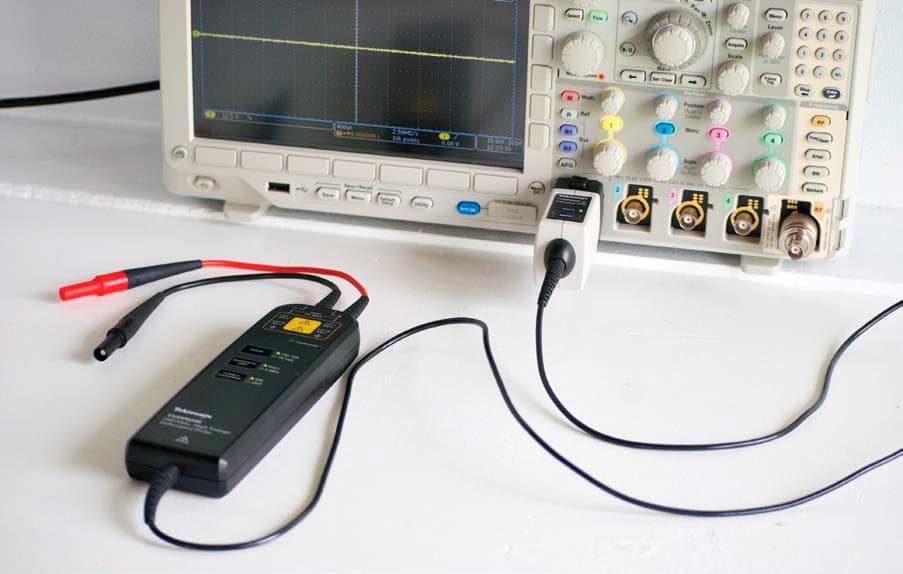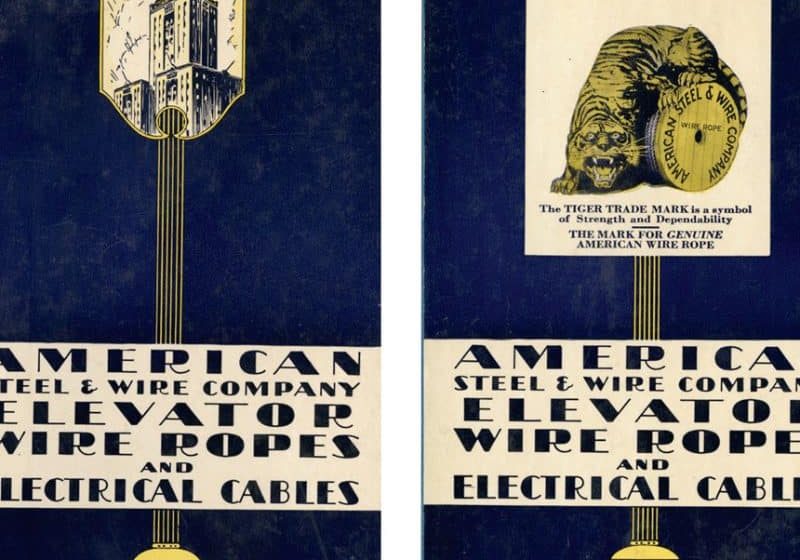Oscilloscopes, Part Two
Jun 1, 2016

The first installment of this series (ELEVATOR WORLD, May 2016) looked at the oscilloscope’s historical roots, including some early innovations and theoretical underpinnings, such as the Fourier Transform. This concluding article will fast-forward to the present and walk the reader through oscilloscope exercises, beginning with the simple and proceeding to the more complex.
Learning Objectives
After reading this article, you should have learned about:
♦ Accessing electrical signals using an oscilloscope
♦ Avoiding fault current
♦ How to compensate the oscilloscope’s probes and why the process is needed
♦ Displaying DC and AC waveforms on an oscilloscope
♦ Using the digital voltmeter function
The oscilloscope is essentially a voltmeter, although like any such instrument, it can be configured and calibrated to read current and resistance. The oscilloscope serving as our sample instrument, the Tektronix MDO3104, incorporates a built-in digital voltmeter. The voltage is displayed in a readout at the top of the screen, accurate to the thousandths of a volt. This obviates the need to estimate the voltage by counting divisions in the reticule, although that can still be done if desired.
Before proceeding, if the oscilloscope is new or if verification is desired, it is necessary to compensate the device’s probes. Due to slight variations in the manufacturing process, the impedance of any given probe is not an exact match to the impedance of the analog channel. If these values are not the same, a square-wave signal (with its very fast rise and fall times) will exhibit considerable distortion in the display. A poorly compensated probe can introduce measurement errors.
When a probe is connected to one of the analog input channels, the probe becomes the source, and the front-end circuit of that analog input channel becomes the load. It is necessary to match the impedance of each probe to the impedance of any analog channel to which it is to be connected. If these impedances do not happen to coincide, it is necessary to adjust the impedance of the probe to make a good match. At one time, this was done by turning a screw on the probe body using a nonmetallic screwdriver. The MDO3104 performs this operation automatically when its on-screen prompts are followed.
Connect the probe to the desired analog input channel, and connect the probe tip and ground reference lead to the correct terminals at the right side of the oscilloscope’s front panel. These terminals are labeled “Probe Comp,” and one of them is marked with a ground symbol. Push the front-panel button for the desired analog input channel. The lower menu will display the probe termination value. Push “More” repeatedly to select “Probe Setup,” then push “Compensate Probe.”
Each of the four analog input channels can store the compensation values for up to 10 separate probes. Beyond that, the oldest stored value will be deleted in favor of additional probe compensations, and the oscilloscope will add the values for new probes as they are compensated. This process must be repeated for each probe/channel combination. Alternatively, a single dedicated probe for each channel can be compensated, in which case the probes must be labeled.
Basic Exercise
Our first hookup will be a 9-V battery. Since it is totally isolated from ground, there is no danger of a heavy fault current, such as when the electrical equipment under investigation is connected to the premises’ utility-derived power. For this reason, it is permissible to connect the probe tip and ground reference lead to either the positive or negative side. There is no need to use the differential probe or the ungrounded handheld oscilloscope.
Notice that the display consists of a single horizontal line. Its color matches the dedicated color of the channel in use. Channel One, for example, is yellow. The voltage level can be estimated by counting the main divisions along the Y axis and the ticks along either side of the display. A more accurate measurement can be made by using the built-in digital voltmeter. To do this, push “Measure” in the “Wave Inspector” section of the front panel. A menu bar will appear across the bottom of the display. Push the soft key that corresponds to “DVM” for the DVM menu bar to appear to the right of the display. The top item is “Mode.” “Off” can be toggled to “On” by pushing the soft key. The lowercase “a” indicates that multipurpose knob “a” is to be used to scroll through the modes, which are “Off,” “AC + DC RMS,” “DC,” “AC RMS” and “Frequency.” (Since the instrument is connected to a DC signal, “Frequency” is not applicable.)
Besides “Mode,” menu items on the right-side menu bar can be chosen using soft keys. Under “Source,” a lowercase “b” indicates the choices can be selected using multipurpose knob “b.” The sources are the four available analog channel inputs, each shown with its dedicated color. The soft key beside “Display Style” toggles between “Full” and “Minimized,” the latter of which eliminates some of the items in the display.
We are now ready to observe the waveform. In this instance, since the signal is DC, a straight horizontal line is displayed. If the ground reference lead is connected to the negative side, the line will appear above the X axis, and the voltage can be estimated by counting the divisions and ticks shown on the reticule. Or, it is possible to get a more precise measurement (to the thousandths of a volt) by making use of the DVM function of the oscilloscope. If the probe tip and ground reference lead are reversed at the 9-V battery, the horizontal voltage line will appear below the X axis.
An internal frequency counter can be accessed by pushing “Measure” in the “Wave Inspector” section. In the menu at the bottom of the display, push the soft key below “DVM.” On the right sight of the display is a menu with the DVM item. Notice the lowercase “a.” This means that items in the submenu can be accessed by turning multipurpose knob “a.” Do so until “Frequency” at the bottom of the submenu is highlighted. At the top of the display, a menu bar that includes “Frequency” appears. As aforementioned, frequency is shown to be not applicable, because the signal is DC.
Most modern digital oscilloscopes are available in two- or four-channel models. The four-channel model typically adds 50% to the price, so it is advised to anticipate usage before making a purchase decision. The MDO3104 has four channels, and everything is color coded, from the individual probes to the channel inputs, displayed waveforms and labels that appear on the screen.
Advanced Exercise One
Another exercise consists of acquiring a display of the AC utility power available at the premises. It is considered more advanced, because one side of the circuit to be measured is solidly grounded, while the other side is fixed at a specified voltage above ground.
A grounded bench-type instrument, such as the MDO3104, as well as the circuit under investigation can be damaged if the probe’s ground reference lead is connected to a wire or terminal that is referenced to ground but floats at some significant voltage other than ground potential. The safe procedure, after plugging the instrument into a grounded receptacle with verified equipment-grounding continuity back to the service equipment, is to connect the ground reference lead to a part of the circuit under investigation that is not referenced to (totally isolated from) ground or is solidly grounded and at the same potential as the oscilloscope’s power-supply ground. First, check the oscilloscope receptacle and the receptacle that powers the equipment under investigation. Use a circuit analyzer to perform this measurement.
To begin, make up a short power cord with a three-prong plug at one end. At the other end, slit and remove a short length of the jacket, and strip the insulation at the ends of the three conductors. Leave a small amount of copper showing to lessen the risk of contact or short circuit. Be sure to terminate the ends at the plug properly so the grounded (white) and ungrounded (black) conductors are not crossed. Keep this cord in a secure place, because in the wrong hands, it can be treacherous.
Attach the probe to one of the oscilloscope’s analog input channels. Be sure the correct channel is turned on by pushing the color-coded numbered button so that it lights. If a meaningful display does not appear, push “Default Setup,” “Menu Off” and “Autoset.” If an analog channel other than “One” is desired, it will have to be switched on, because “Default Setup” always takes the oscilloscope back to channel one.
A sine wave as generated by the utility should now be visible. There are several aspects of this display worth noting. First, a sine wave is characterized by the fact that there is a greater rate of change at a lower level (closer to zero) voltage level, and a lesser rate of change at a higher level voltage level. That is why the curve levels off and becomes flatter at the peaks. It is a consequence of the rotary nature of the machine that generates the power.
Another noteworthy aspect of the display is that, since the “Default Setup” and “Autoset” buttons were pushed, the waveform is centered on the X axis. This position can be adjusted by turning the small knob above the channel-selecting button. Pushing this knob re-centers the display on the X axis. The large knob below the channel-selecting button changes the vertical scaling. Notice that, as this is done, the number of volts per division (shown at the lower-left corner of the display) changes accordingly. Push “Autoset” to return to the default view.
The horizontal position and scale knobs perform similar alterations, and, here again, “Autoset” restores the default settings. In the “Trigger” section, the triggering level can be raised or lowered from the zero level (with reference to the Y axis). Notice that if this level is moved above the positive or below the negative peak, triggering no longer occurs, and the waveform becomes unstable. Pushing “Autoset” moves the triggering level back to 0 V, and the waveform re-stabilizes. Another interesting experiment is to insert a diode in the black (hot) line. This can be done using a wire nut, and it creates a half-wave rectifier.
If the diode is reversed, the half of the waveform that is blocked will be of opposite polarity. The remaining half of the sine wave will appear on the opposite side of the X axis. A full-wave rectifier could be built with two diodes with a center-tapped transformer or four diodes with a transformer that is not center-tapped. The entire waveform would appear on one side of the X axis. A further experiment would be to construct a filter using a capacitor and/or an inductor to see how much ripple can be removed.
Throughout all of this, remember to refrain from connecting the ground reference lead to any wire or terminal that floats at a different voltage with respect to ground. A center-tapped transformer may carry the grounding through to the center tap due to an intentional internal connection or an unintentional short circuit. Isolation from ground can be verified by means of a neon test light. If any part of the transformer output is referenced to ground and floating at a different potential, it is necessary to use alternate instrumentation. One way to make such measurements is to use a high-voltage differential probe such as the Tektronix TMDPO200. Another alternative is to use a handheld, battery-operated oscilloscope such as the Tektronix THS3024.
Advanced Exercise Two
Another interesting experiment (with the diode from the previous experiment removed) is to connect the probe, still hooked to the utility AC, to the radio-frequency (RF) input. The display, now graphing the sine wave in the frequency domain, shows power distribution plotted against frequency (rather than time) on the X axis. The irregular trace along the bottom is the noise floor, caused by random motion of electrons. Since the input is a pure sine wave without harmonics, the power distribution as shown in the frequency domain display (below) and the spectrogram (above) is a single spike. All the signal power is at a single frequency. The oscilloscope is capable of doing this translation, because it electronically makes use of the Fast Fourier Transform, a fairly intricate set of computations (EW, May 2016).
For the next experiment, remove the AC source and connect the probe back to an analog channel. We will configure the instrument so that it can display any sound, including that made by the human voice via a microphone. The first thing to realize is that there are two types of microphones — those that require external power and those that do not. A carbon microphone works well in this application, but its problem is that it requires external power. The device consists of a small container of carbon particles. Changes in air pressure successively compress and decompress the carbon, making the overall device more and less conductive. Since the oscilloscope is essentially a voltmeter (rather than an ohmmeter), an external DC power supply is needed. A 9-V battery works well, except for the fact that (as seen by the oscilloscope, which is auto-ranging), the DC voltage will overwhelm the electrical fluctuations that correspond to the sound. To correct for this effect, a capacitor can be placed in series with the microphone to eliminate the DC current.
A simpler solution is to use a microphone that does not require external power. Such a microphone actually generates electrical energy from within. A loudspeaker is, in reality, a lineal or non-rotary, externally commutated DC motor. Like other DC motors, it is also a DC generator. Noise (such as speech) can be made in the vicinity of the cone, and the microphone will transform variations in air pressure into a fluctuating voltage. Accordingly, the speaker can be connected directly to the oscilloscope probe.
Other Uses
The waveforms of many virtual musical instruments can be viewed by connecting an oscilloscope to an electronic keyboard. These signals are considered rich in harmonics and can be viewed in the frequency domain and the spectrogram. However, do not wire the oscilloscope directly into the headphone jack. This could blow the output transistors (final amplification stages). Seeing the very high input impedance of the oscilloscope probe, they would be run into an essentially open circuit and overload the circuit. Another issue that could be problematic is that one side of the output could be referenced to ground but float above or below it. Instead, use the speaker hookup discussed above. Place it near the keyboard speaker, and neither oscilloscope nor keyboard will be jeopardized.
An oscilloscope is very useful in troubleshooting audio and video equipment. The usual procedure is to inject a signal into the input and, using an oscilloscope, view the signal at successive stages. Some TV schematics include graphics that depict healthy waveforms at different points in the circuitry. An oscilloscope trace reveals more information than a mere voltmeter reading, and it is often possible to narrow down the defect first to the stage, then to the circuit and, finally, to a bad component. Traditionally, a signal generator, also known as a “function generator,” was used for this purpose. A specific, unvarying signal of this sort is preferable to using the broadcast coming in via an antenna, because it does not vary and provides a uniform waveform that may be viewed and compared at various points.
Advanced digital oscilloscopes such as the MDO3104 incorporate an optional internal function generator capable of synthesizing a variety of signals. Frequency, amplitude, duty cycle and offset from the X axis can be modified. This model has two ports on the back panel where the arbitrary function generator (AFG) signal can be accessed. It can be either injected into a circuit under investigation, or it can be fed back into the oscilloscope through any of the analog channel inputs for the purpose of viewing. To do this, a short length of Bayonet Neill–Concelman (BNC) cable is used. This is standard coax with special ends that have excellent frequency response but are not compatible with coax connectors. Adapters are available.
A number of waveforms may be viewed and modified. Sine, square, pulse, ramp, DC, noise and others are available. Additionally, waveforms from signals fed into the four analog channels and the RF channel can be stored in the oscilloscope’s memory, edited as desired and accessed at any time in the future. Noise can be added to a signal of interest to see how it is affected. Additional signal modification can be performed using Tektronix software, available for free download at www.Tektronix.com.
The oscilloscope is a great instrument for troubleshooting and diagnosing faulty electronic equipment. Moreover, viewing waveforms at various points in the circuitry is enormously instructive and provides insight into some basic physical properties of our mysterious universe.
Learning-Reinforcement Questions
Use the below learning-reinforcement questions to study for the Continuing Education Assessment Exam available online at www.elevatorbooks.com or on p. 137 of this issue.
♦ How can the oscilloscope be protected against fault current?
♦ How is the AFG accessed?
♦ How are multipurpose knobs “a” and “b” used?
♦ How is a circuit analyzer useful in avoiding fault current?
♦ Why are sine waves flatter at the peaks?
Get more of Elevator World. Sign up for our free e-newsletter.







